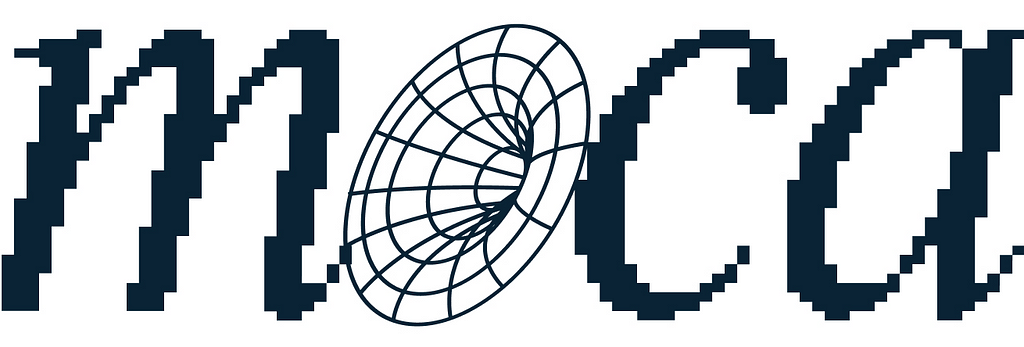-the M○C△ team

Towards Decentralizing M○C△
A Museum can both preserve or challenge the status quo, positioning themselves as a force for gatekeeping or for truth-seeking, all their decisions collectively demonstrating the core values they hold.
A Museum’s art collection, its educational content, written essays, membership strategy, and curated exhibitions are all political and ideological decisions with widespread cultural ramifications. Non-profit, public arts institutions carry a great responsibility, and they cannot develop their artistic approach frivolously.
Decentralization offers a new avenue for humanity in group decision-making and social collaboration. To date, few arts institution have begun the process of decentralization and none have successfully achieved it. It is crucial for the institution to have both a technology stack and an internal hierarchy that pragmatically allows the organization to distribute power equitably among its community. As a blockchain-native institution, the Museum of Crypto Art will always innovate and explore the capabilities of web3 technology. We will minimize the gatekeeping that monolithic approaches to Museum-ship have historically upheld.
Current State
Throughout M○C△’s existence, we have steadily leveraged Ethereum NFTs and the Polygon blockchain to maximize our community’s input in our decisions.
That has taken the form of:
- M○C△ Permanent Collection, recognizing early pioneers of Crypto Art. Currently 251 artworks by 251 artists, approved by our Artist Council.
- $MOCA token, launched in May 2021 and airdropped to all users of OpenSea at that point.
- M○C△ Multipass, free membership to the Museum for individual users. A gas-less, basic tool to categorize and activate NFTs, and the entry point to access the Museum’s full curatorial technology stack.
- M○C△’s Community Collection, the world’s largest decentralized art collection, with over 9200 artworks today. All artworks permanently archived via Filecoin.
- M○C△ Show, a 2D collaborative vehicle for the creation of aesthetic and topical crypto art showcases.
- M○C△ ROOMs, 3D sculptural objects that elevate the curation and exhibition of crypto art to an architectural dimension in the Metaverse.
Why Decentralize Programming?
Crypto Art’s proliferation has largely resulted from its immediacy, its ability to capture shifting global cultural norms and to realign itself according to new information, new precedents, and new voices. By offering M○C△’s community of artists, collectors, curators, technologists an opportunity to directly influence (via decentralized voting system) the Museum’s curation, we will strengthen our alignment with cryptocurrency’s underpinning values: decentralization, reactivity, and democracy.
Values Worth Sharing
- Minimizing cultural and political bias
- Censorship-free discourse and creativity
- Promoting diversity of ideology, points of view, and ideas
- Maximizing global accessibility to cryptocurrency, NFTs, and artistry
- Empowering lesser-known communities and artists
- Maintaining independence from centralized powers, i.e. big business, venture capitalists, government entities
- Ensuring that fun and inclusion remain foundational in the crypto art experience
How We Decentralize
Phase 1 — Thematic Programming Voting System (Jan 2023-June 2023)
Using our Snapshot tool, we will propose three different programming themes to the community each month. Themes will cross art, politics, and philosophy. For example: Trash Art, or Seeing in Code: Minimal Abstraction. After choosing a theme, the community can help curate/select Exhibitions (virtual or IRL), Artist interviews, Collaborations, Podcasts or Twitter Spaces, and Essays.
Initially, these programs will be proposed by Museum principals, but in long-term will be fully selected by the community.
Phase 2 — Expanded Voting System (6 Months)
Two programming proposals will be offered by the Museum itself, with the third proposal being both submitted and selected by the community. M○C△’s artist council will have final approval over suitable selections (this is mostly to filter out trolling, which we all know can be powerful).
With the presumptive success of this extended trial program, we hope to expand community-driven proposals to the fullest possible extent.
Who Can Vote in Snapshot?
M○C△ Points will be the primary weight factor when voting, allowing users a stronger influence on the path the museum’s curation will take.
M○C△ Points are a weighted aggregation of how much $MOCA one holds and one’s level of interaction with our ecosystem of tools: $FLOOR, $ROOM, $MOCA token, staked liquidity, community POAPs, likes and comments in our Dapp, etc. ****This customized configuration allows M○C△ to offer voting power that is aggregated from On-chain engagement plus other more diversified interactions. The more one uses our platform, the more Points one earns, expanding the influence one can have in the Museum’s future programming.
How to earn MOCA Points?
Owning M○C△ ROOMs NFTs grants a large amount of Points. Holding $MOCA on Polygon or Ethereum increases M○C△ Points as well. A point multiplier can be earned by Staking $MOCA Tokens (note: LP tokens and Quickswap pools offer the best Token-to-Points ratio).
One can also increase M○C△ Points by actively engaging in the community (Discord, Twitter, etc.). Acquiring various M○C△ POAPs (often through Museum missions on our Discord) grants Points, as does social activity in the form of On-chain comments and likes upon pieces in either of the Museum’s collections.
Future
Ownership of $MOCA Token remains the primary influence over decision-making processes within the Museum. $MOCA ownership translates to proportionally greater participation in the Museum’s programming proposals. In the long-term, $MOCA will lead our transition from single-owner curatorship to a quasi-DAO to a full DAO.
We envision M○C△ becoming a truly-decentralized vehicle for cultural output and reflection. In the future, we dream of a community which, through social interactions, shapes the Museum’s complete program, with the M○C△ team acting more as facilitators of that cultural output rather than its architects. We hope (and believe) that this system will inspire a multiplicity of voices and points-of-view; provide a natural, scaleable platform for diverse and cutting-edge ideas; and create a rich, inclusive cultural output.
We invite you to be a part of this most experimental path with us. We need you, and everyone who is interested in art and culture, to join us. This will be — must be — a collective effort, and cannot become a reality without a strong, committed, and active community.